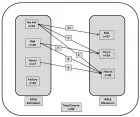Table of Contents
Justification of the Principles of Emergency Care for Acute Pneumonia
Published on: 29th April, 2025
The action of modern emergency care for patients with AP, on the one hand, requires a wait-and-see period, which is unacceptable in cases of rapidly progressing inflammation. On the other hand, it uses methods that do not take into account the featur... es of the disease mechanisms. All this creates conditions for an excess of complications and treatment failures. The accumulated facts on this problem indicate the need to revise the principles of treatment. Consequently, the most important initial step in this direction seems to be the correction of professional views in accordance with the classical provisions of medical science. Show more >
Alternatives to Apical View in Predicting Fluid Responsiveness by Transthoracic Echocardiography: An Observational Study
Published on: 14th May, 2025
Introduction: Flow analysis in the apical view of transthoracic echocardiography is validated to assess fluid responsiveness at the bedside. Still, it is not always reachable, especially in mechanically ventilated patients and during surgery. We comp... ared it to supra-sternal and sub-xiphoid views to evaluate their validity in assessing fluid responsiveness in critically ill patients.Method: A cross-sectional prospective monocentric pilot study of three months duration has been led in the critical care unit for surgical emergencies of Ibn Sina University Hospital of Rabat (Morocco). We used the time-velocity index (VTI) and peak velocity variation (∆Vpeak) values correlation between the three acoustic windows as the main judgment criteria. Measurement of data was made in the Left Ventricle Outflow Tract (LVOT) in the 5-chamber apical view, Descending Thoracic Aorta (DTA) in the supra-sternal view, and Right Ventricle Outflow Tract (RVOT) in the sub-xiphoid view.Results: There were 14 adult patients involved in the study, and the data presented are preliminary results. There was no significant difference in VTI and ∆Vpeak values between the three acoustic windows at each time of the study protocol, with a very high correlation for initial VTI value between 5-chamber apical view and supra-sternal view (r = 0.96, p < 0.001), and sub-xiphoid view (r = 0.86, p < 0.001). A very high correlation of initial ∆Vpeak value was also observed between the 5-chamber apical view and supra-sternal view (rho = 0.89, p < 0.001) and sub-xiphoid view (rho = 0.79, p < 0.001).Discussion: Supra-sternal and sub-xiphoid views showed high potential to predict fluid responsiveness, but further data are needed to validate their use for this purpose in ICU and in operating room. Show more >
Cerebral Autoregulation-Directed Therapy in Adults with Non-Traumatic Brain Injury in Neuro-Critical Care: A Scoping Review
Published on: 15th May, 2025
Cerebral Autoregulation (CA)-directed therapy, or optimal cerebral perfusion pressure (CPPopt)-targeted therapy, is a tailored bedside method of resuscitation used in critical care that aims to achieve and maintain the CPPopt, to fit the precise cere... bral hemodynamics and metabolic demand. Different processes and multiple tools are available to conduct a CA-directed therapy in acute brain-damaged adult admitted into critical care settings, but literature is limited and primarily focused on traumatic brain injury; however, for other brain conditions. By this scope review, we aim to describe the main procedures used by authors to achieve a CA-directed therapy, as well as its acquisition methods and its usefulness in acute non-traumatic brain-damaged adult in neurocritical care. Show more >
The Power of Potentized Complementary Medicines at Nanoscale for Infectious Diseases Management
Published on: 22nd May, 2025
This study explores the effectiveness of Homeopathy in managing infectious diseases, focusing on its integration with nanoscience. The key objectives include assessing the role of homoeopathic treatments in reducing morbidity and mortality from vario... us infections, such as respiratory, gastrointestinal, and mosquito-borne diseases, and examining the scientific mechanisms behind its therapeutic effects.Key findings from the study include evidence of nanoparticles in highly diluted homoeopathic solutions, suggesting that these remedies may retain measurable amounts of the original substances. This nanoparticulate perspective bridges traditional homoeopathic practices with modern nanomedicine. Historical evidence, such as Hahnemann’s work on scarlet fever and recent studies during the 2006 Chikungunya epidemic, supports the effectiveness of homoeopathic treatments, demonstrating improved recovery rates and reduced complications with integrated homoeopathic and allopathic approaches.The main conclusion of the study is that Homeopathy, particularly when combined with nanoscience, holds significant promise as a complementary approach in the management of infectious diseases. The presence of nanoparticles in homoeopathic remedies may explain their therapeutic effects, positioning Homeopathy as a valuable component of holistic healthcare strategies, especially in developing countries. Show more >

HSPI: We're glad you're here. Please click "create a new Query" if you are a new visitor to our website and need further information from us.
If you are already a member of our network and need to keep track of any developments regarding a question you have already submitted, click "take me to my Query."


















































































































































